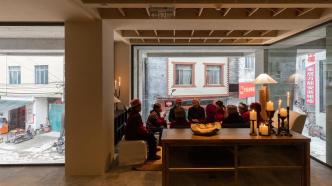
Since 2022, the filming team of Dragon TV's home improvement program "Dream Renovator" has been working in Donglan County, Guangxi for nearly two years. It rose from a parking lot and built a multi-functional B&B building with Guangxi's local characteristics. , this is the home of the client Wei Hongnian, and now it has become everyone’s “home”. This is one of the largest renovation projects in the 10 years since "Dream Renovator" was launched.
On November 20, a reporter from The Paper embarked on an on-site visit to a model house in Donglan. They flew from Shanghai to Nanning, then took a four-hour bus ride from Nanning Airport to Donglan, a small county surrounded by mountains. After passing through various auto parts factories, ceramic tile shops, and snack bars, I finally saw Wei Hongnian's B&B hidden in a residential area.
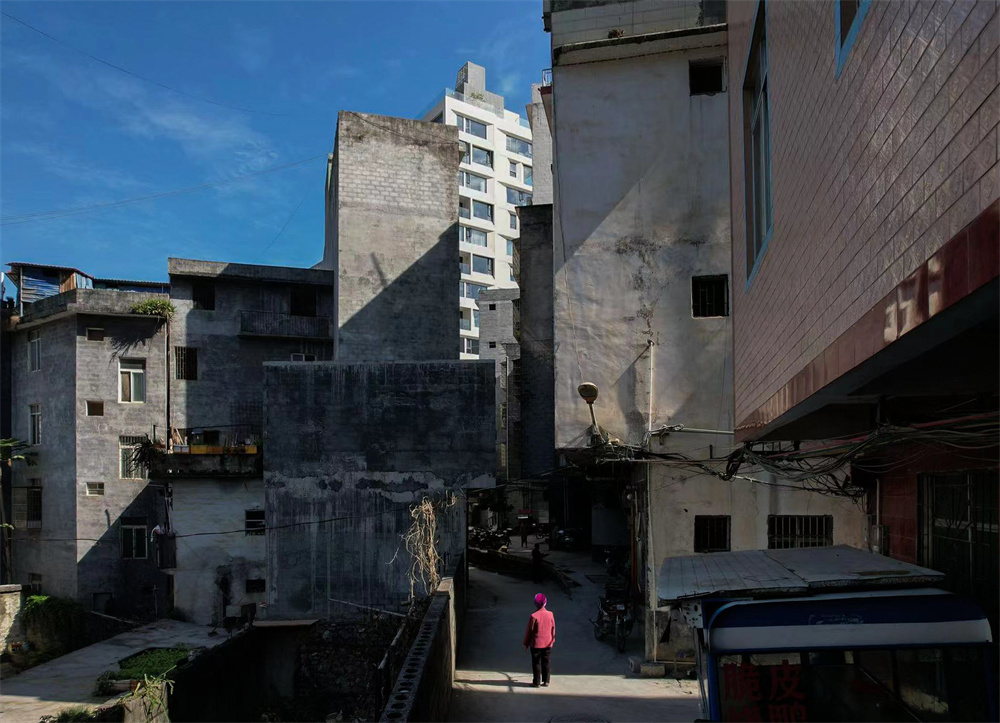
Donglan County, Hechi City, Guangxi
Donglan County, Hechi City, is unfamiliar to most people. It is located in the northwest of Guangxi Zhuang Autonomous Region and is rich in natural resources. What makes local people proud is that Donglan County is a famous old revolutionary area in the country and the hometown of Wei Baqun, one of the three early leaders of the peasant movement. The five founding generals Wei Guoqing, Wei Jie, Qin Jian, Wei Zuzhen and Qin Shimian were born here, and it is known as the "Hometown of Generals". In this county, which is mainly composed of Zhuang people, "Wei" is a common surname.
Compared with the scattered and intersecting "handshake buildings" unique to small southern towns, the appearance of Wei Hongnian's second-phase expansion of the B&B does not look very out of place. In the words of designer Gu Yi, it is "harmony but different".
The wide windows of the building make the privacy emphasized in B&Bs in the past become more shared space. Whether indoors or outdoors, the four-season mountain scenery and human fireworks can be captured. Upon entering, the hustle and bustle of the city outside is cut off by a sense of quiet space. Not only travelers from out of town, but neighbors can also come here to stroll, chat and relax.
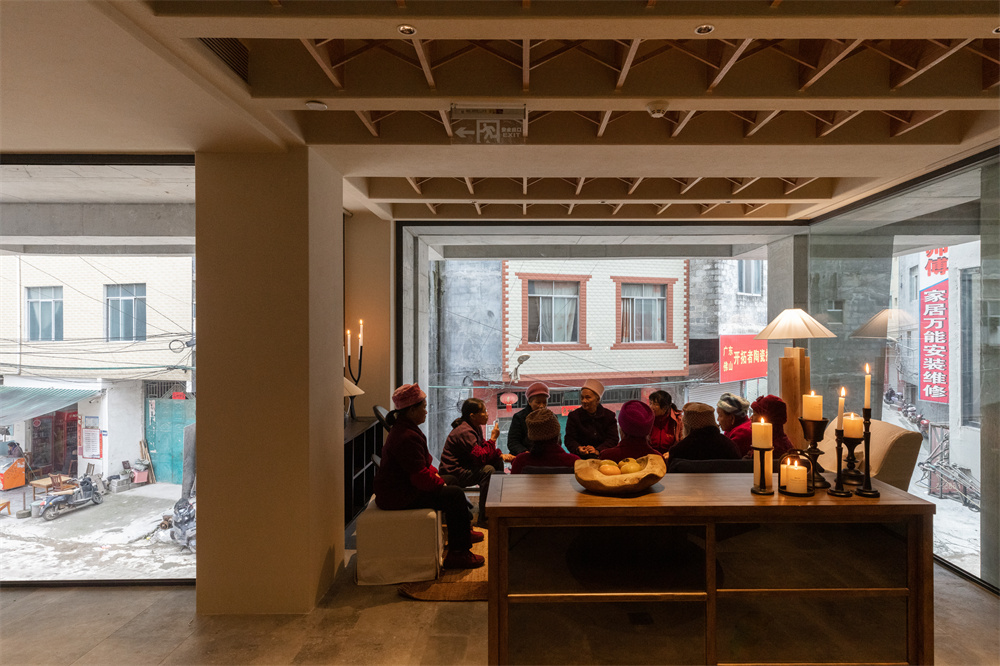
Neighbors relax and chat here
Outside the gate, several Zhuang elders were sitting together to bask in the sun, greeting the director team enthusiastically in dialect. "They come here often, and they also watch this building being built bit by bit, and we are all familiar with it." The director said, "We have designed a specially designed area on the first floor. We hope that when the weather is bad, the elderly can also Let’s get together and chat as usual.”
Although it has not yet been officially opened, everything is still in its initial state. The owner Wei Hongnian worriedly informed us that there might be concerns about "high-pressure trial and error" upon meeting. Please bear with us, but the warm welcome from everyone at the B&B also instantly infected everyone.
A cup of warm Liubao tea and a few pieces of sweet glutinous rice cake will make people who have traveled here feel the warmth of returning home.
As everyone knows, like many young people in the county, Wei Hongnian, who has a strong nature, wanted to leave this home when he was young.
1
At the age of 14, Wei Hongnian left home to study in Nanning, the provincial capital, and later stayed in the big city to work hard to build a career. A few years ago, her father's death became a turning point in her life's development. She decided to return part of her life to her hometown of Donglan and spend more time with her family.
Zhang Kele, the director of this episode, told reporters, "As early as the 1980s, Nian Nian's father became one of the first people in his hometown to get rich. He opened the Donglan County Machinery Factory and the Cement Factory, and his products were exported to Southeast Asia. After the family's financial situation improved, Nian Nian's father became one of the first people in his hometown to get rich. Nian Nian’s father took the initiative to fund the construction of bridges and roads and participated in public welfare undertakings in his hometown. His father’s words and deeds also gave Nian Nian such a motivation.”
Considering that Donglan's urban construction is relatively lagging and its cultural and leisure industry is still immature, Niannian re-planned her family's homestead under the tide of rural revitalization and eco-tourism development. At her family's suggestion, she built the first building in Donglan County. B&B.
Under careful operation and maintenance, Niannian's B&B has received a lot of praise from tourists from other provinces and local people of all ages. It has even attracted the attention of the Donglan cultural and tourism department - they hope that Niannian can expand the existing B&B and build a new building. B&B buildings with complete supporting facilities and urban public attributes will set a model for the cultural tourism industry in the hometown.
While making tea by the fire on the terrace in the evening, Wei Hongnian told reporters, "Young people are now willing to go back to their hometowns. Here we can still gather, communicate and update information. It is actually not easy to live in a big city to work. Now there are With these conditions, being able to be closer to their parents and friends, and having a good income, young people will of course choose to go home."

rooftop
There are several tents set up on the terrace. Under the candlelight and music, it creates a sense of separation from the county scenery below. The terrace does not belong to Nian Nian. It originally looked like a large rooftop filled with debris from her neighbors. The designer suggested to her that she could rent the neighbor’s rooftop and design it as an open-air camp where she could cook tea and barbecue around the stove. The neighbors could also use the terrace. It can be used at any time, which not only provides the B&B with an additional outdoor activity venue but also brings neighbors closer.

2
Donglan County is shaped like a "chuan", with a river in the middle and main roads and residential buildings surrounding the river on both sides. The locals have a saying to describe the "smallness" of the county in the early years - "Strike a match and walk from one end of the county to the other, and the match will not burn out yet."
Designer Gu Yi recalled that when she first entered Donglan, she felt it was “fresh” and “magical”. The most impressive thing is the "handshake building", the most ordinary house where Donglan people live. The average distance between adjacent buildings does not exceed 1.5 meters. Over the years of construction, self-built houses have taken advantage of every opportunity, resulting in a closed block pattern and blocked traffic and sight lines. In such a compact living environment, the daily life of local residents still retains some four-season customs connected with nature.
"The buildings are so close together that there are no windows between them," Gu Yi said. "You can see from the roofs that not only clothes are dried on the roofs, but also vegetables are grown and grains are dried."

rooftop
Gu Yi believes that ordinary counties like Southeast occupy more than 80% of China's land area. Many of these ordinary counties have no funds or tourism resources. Due to the external geographical restrictions of the Southeast and the lack of inherent commercial superiority, the starting point and purpose of this project changed. This also doubled Gu Yi's pressure, so the project came and went for 10 months.
At this time, he happened to see the book "Looking at Hometown in the City" and was very moved. There was a title in the book called "Whose City is Whose Hometown?" Gu Yi thought that sentence was very heavy.
Why do so many people leave the countryside for the city like migratory birds? After working hard for a year and only having a short holiday when returning home, Gu Yi was thinking, what can we do for these young people who have left their hometown? How can design really come back to the project itself?
"Nian Nian really wants to do something for her hometown and the young people in her hometown. Not everyone can do this. Before we got involved, every time we came, (Phase 1 B&B) Often the rooms are full at night, but there are still some villagers, maybe drunk, who come over to ask for a cup of tea. The feeling is very warm, they really regard this place as their home." Gu Yi sighed with emotion. say.
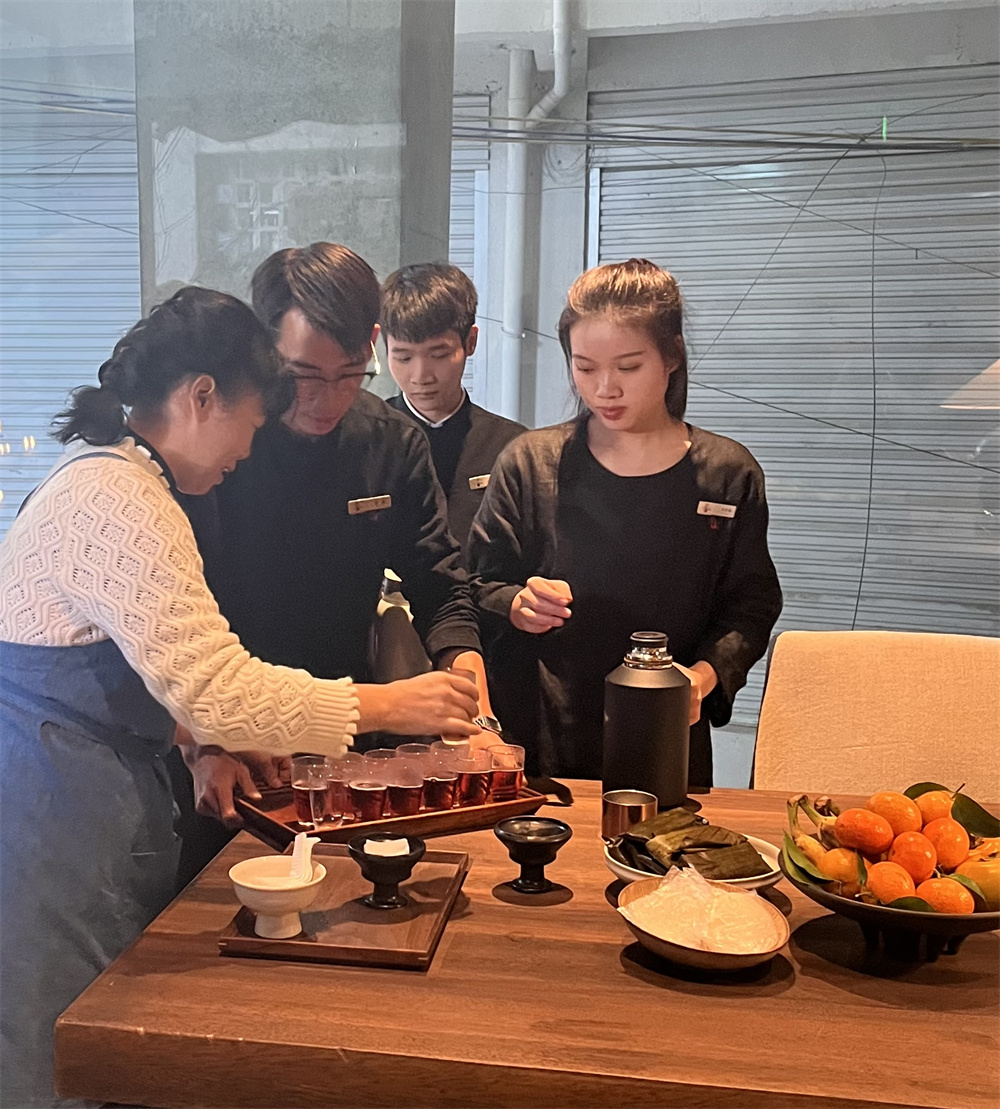
Owner Wei Hongnian (first from left)
3
In the interview, Gu Yi talked about the key points of project design: "taking a step back" and "taking a step forward".
In the cramped urban village space, how to create a safe space without wasting too much land (the project covers an area of only more than 100 square meters). From the street perspective, first create a transparent public area between several buildings. Back out of the atrium. The second "retreat" is to give up part of the commercial space to the neighbors in the streets as public spaces, including the atrium courtyard, sky teahouse, and top-floor Tonggu Academy, so that neighbors can have more gathering places.
In the exterior construction of the B&B building, Gu Yi fully respected the customs of the local urban context, designed the first and second floors to be set back, and used a light steel structure for the facade shape, making the exterior wall more staggered and in line with the entire The urban landscape is "harmony but different".
In terms of room types, the designer designed 8 different room types based on the shading and lighting relationships of the floors to meet different consumer needs.

Designer Gu Yi
It is worth mentioning that in the public area, Gu Yize built the high-rise Tonggu Academy into a multi-functional living space for exhibitions, meetings, and activities, giving community residents a public space for calligraphy, reading, and conversation; in addition, he It has also opened up an elegant, private and aesthetic tea space to meet the tea culture needs of local residents.
In the construction of the restaurant, underground atrium, and sky shared garden, designer Gu Yi also adapted to local conditions and skillfully incorporated local elements such as Donglan bronze drums, Zhuang embroidery, and Chinese medicine names. Use a delicate and warm design language to connect the scattered and fragmented spaces into a complex place space that is related and distinct.
While living there, the reporter discovered that there are many local elements in the soft furnishings of the B&B.
For example, decorative paintings made from Guangxi Zhuang embroidery;
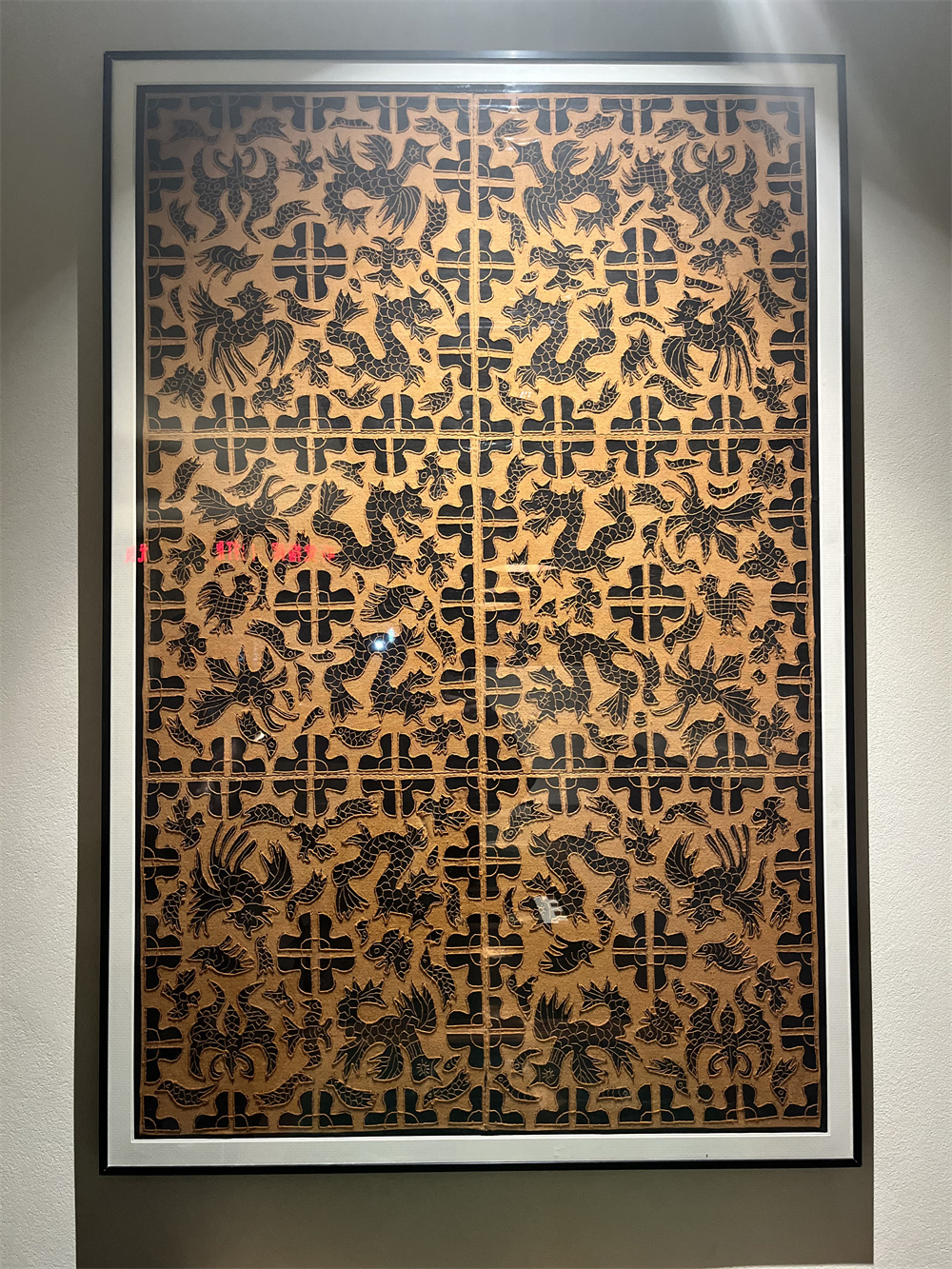
an art installation made from local bronze drums;

I made some art installations using the abandoned lathe of the original owner’s father.
In addition, the guest rooms fully respect the owner's daily furniture collection for reasonable matching, and also add soft decoration and visual design based on Guangxi Zhuang folk arts.

4
"I think what Nian Nian wants to show everyone is not a decent B&B, but a new state of life that she has accumulated over the years and wants to show everyone."
Gu Yi commented: "Nian Nian said something that particularly touched me. She said, look at the children here, why do some people from birth to death not be able to see the beautiful things that we can see? Ni Nian She likes traveling very much, and she especially hopes to bring these beautiful things back. She feels that people in any place have the right to experience beautiful things, even if they cannot go out."
Regarding this dream transformation, Niannian said that they still have a tacit understanding with each other. Maybe because everyone has the same original intention, many things are self-evident.
China's urban development has entered a new stage in which "stock renewal is the main priority", and urban renewal has become an inevitable choice for sustainable urban development. In recent years, various urban renewal cases have emerged frequently, such as Shenzhen’s “Nantou Ancient Town”, Guangzhou’s “Enning Road Yongqingfang Renovation”, and Fuzhou’s “Yantaishan Lequn Road.”
Director Zhang Keke finally told reporters, "These renovations are all in big cities, but many old urban areas in small counties are now in urgent need of updating. Different from big cities, in small counties, small towns, and rural areas, , there are many homestead houses that are partially idle, or have been vacant all year round. This renovation attempt also aims to try to use the resources of idle houses in the county and make a new attempt based on the rigid needs of the development of the cultural tourism industry."


